page 27
Progressive Thinkers as of 5/8/2020
|
| ||||||||||||||||||||||||||||||||||||||||||||||||||||||||||||||||||||||||||||||||||||||||||||||||||||||||||||||||||||||||||||||||||||||||||||||||||||||
If it is difficult to define an activity in order to engage in a methodology of assignment using enumeration, then why do we humans do it... more-so now in the present then they seemingly did in the past? Why the impetus to enumerate instead of using some other type of cataloguing system? Does the usage of numbers breed more equality such as making sure each sports team has the same number of players? They why should Nature engage in the usage of odd numbers if even numbers suggests parity or even equilibrium? Unless equality is an illusion and numbers can be used to support or deny equality even when the same number is used such as pitting 3 bulls against three ants. Even one bull against 3 ants indicates that the "1" is superior to the "3" in this context, and the 1 is superior to the 3 if one is speaking of the numbers in terms of 1st and 3rd place in a race. Clearly, numbers can be used arbitrarily to reinforce one perspective over another, particularly if we are using a number as a symbol to reference a quality of a given quantity and then assume a greater number for qualities thought to be superior.
For example, one might describe the triplet code of DNA to be superior to the presence of the "2" when assigned to the quantity of strands called a double helix, since the single-stranded RNA is also governed by this triplet code; even though we see a 3 -to- 1 ratio when we look at the underlying similarity and differences between DNA and RNA... specifically, both have the same Adenosine- Cytosine- Guanine nucleo-bases with the difference seen in DNA having Thymine and RNA having Uracil. A group that is sometimes counted overall as being a "5": Adenosine, Cytosine, Guanine, Thymine, Uracil. It is quite reasonable to suspect that a count of "5" is used in an attempted form of abbreviation, because those holding such a perspective may not be familiar with a collection of different 3 -to- 1 ratios, even though they should be aware that Mendelian genetics displays this same ratio.
I don't care what number pattern a person prefers, because even a person's lies, deceptions... intentional or otherwise, can be cataloged as an example and when multiple examples from different subject areas are tabulated, we can see some number patterns showing up more so than others. This is irrespective if a given perception involved in a give subject is obsessed with a given number such as 2 or 7 or what-have-you. Most people do not share the same obsession. Hence, some instances of a given pattern from a given person may well be better interpreted to be an anomaly. For example, we do not see most people making a collection of "threes" as I am nor pursuing an attempted comprehensive deduction and explanation for such a recurrence of this pattern. And while my activities might be viewed as a behavioral anomaly, let us remind ourselves that many a professional are anomalies. And even though some individuals would want to claim themselves to be an anomaly defined in terms of uniqueness like those in a given street gang, sports club, or selective occupation, they are actually an expression of mediocrity... easily seen in an Legislature, police force and street car races, rapper, magician, singer, musician, etc...
Several people have taken the time to collect examples which... to them... represent a given pattern, be it a number or otherwise. For example, let us say we have twelve people and each of them collect 25 examples of a given pattern. If six of them have collected the same examples and six of them have collected the same patterns but are different from the first group of six collectors, sharing the collections amongst all 12 would produce a list of 50 examples altogether, with everyone sharing the same value to which we might interpret to be an average, a maximum or as an expression of mediocrity if everyone else who copies them repeats the same list. In one setting, quantity of examples may be used as a measuring tool to imply some desired uniqueness of standing out and above everyone else interested in the activity. On-lookers might view the activity as a game and a silly game at that. However, if we are in the occasion where 50 examples is the maximum to be achieved by anyone, then distinction or uniqueness might thereafter be interpreted due to a particularly defined perspective of one or more of the examples. Having spotted a pattern existing within the listed quantity may be cause for celebration because it invites an opportunity for participants to engage in discussions which permit individual impressions, explanations and further interpretations in a setting which has now opened the field up to players engaging in a one-upmanship activity. Hence, one can come to claim theirs or another's analysis is far more interesting, more important, more applicable, more suitable for a given situation, etc....
As more and more people become interested in a topic, the topic may take on a label which describes it as a separate discipline of study, or some already present discipline of study may want to incorporate it into themselves by calling it a branch or sub-field of investigation, much in the manner that religion stakes a claim of ownership to the topics of god, morality, heaven, hell, angles, devils, etc... Such fields of study like Mathematics, Medicine, Philosophy, Archeology, Anthropology, Literature, Physics, Animal Husbandry, Music, etc., are not inclined by their respective practitioners to see themselves as branches or sub-fields of a discipline that has not yet been defined or labeled. Like many a people afraid to have their DNA tested to see if they have some genetic connection to other races, academic and externalized fields of study are like individuals who judge themselves by simple external clues and not shared recurrences of patterns underlying expressions of surface materials, though those materials are viewed as "deep" or "basic" or "fundamental" patterns of cognitive activity. Like prejudiced people not wanting to see that all people share red blood or a similar skeletal structure or similar biological make-up, e encounter the same prejudice and discrimination in subjects whose partitioners may think they are engaged in activities and ideas which prejudice and discrimination have been eliminated by some assumed purity of thought or intent.

I have confronted many different types of professionals with the view concerning a recurrence of the "three" pattern, and every single one has reacted in what can be described as a bias or prejudice... the latter word especially prominent when confronting theologians obsessed with the number "7". Instead of saying they are not familiar with the particular study of "threes" (though some have responded honestly by saying they had never heard of it), I find many of them reacting defensively. Yet, perhaps I am to blame because I used to be much more insistent in presenting the threes idea than I practice today during a face -to- face encounter with someone. One individual even said I had Way TOO Much Time on my Hands, after I recited several examples during a moment when they were waiting on me to collect some screws I had ordered and was picking up at a Will Call desk. But let's be fair, most people that I encounter are not familiar with the topic and those that are generally think of it in a singular context such as Fairy Tales. Hence, I have taken a step back and viewed my position as that of someone like Johnny Appleseed, except that my seeds are the topic of threes, which may or may not take root in the consciousness of someone. I think the phrase "Johnny Appleseed of Threes" might make for a good T-shirt, ball-cap or bumper sticker emblem. In fact, if you look at the accompanying picture, it illustrates a character who is more interested in their self-driven task then they are in the upkeep of their appearance. While I am not that rustic looking, I neither take on the custom of being described as a dandy, wearing corporate business attire or ostentatiously fashionable with an "upper crust" logo-enriched wardrobe. This would require someone in my life whose taste in clothing matches their financial capability to ensure such a sustained "other-worldly" image... but then again, my friends might then call me an alien.
When a person looks for patterns, whether it is cognitive patterns, fashion patterns, demographic patterns, patterns in music, art, speeches, education, biology, physiology, physics, anthropology, the stock market, criminal investigation, etc..., an overview in terms of comparing one's findings to different cultures is to consider whether or not one's findings are in part or whole due to a cultural bias. Because cultural anthropologists have documented certain patterns which occur to a given culture and that they appear to be different from one or more cultures in a labeled specific or general way, it is of need to take such a perspective into account. However, we must also think in term of biases coincident with the entire human species. Indeed, life on Earth as opposed to life on some other planet may well influence particularities of cultural practice, of physiology and of course ideas being generated by those subjects presented as truth-seeking adventures such as mathematics, biology, medicine, physics, etc... And though I did not include music in this list, it is difficult to determine if one uses music to seek some universal truth or merely some popularity and financial position in a particular culture. How many musicians use music to seek a greater truth, of exploring reality such as is expressed in the words "music of the spheres"?
The Biology section at this website has frequent visitors, though the collection of "threes" patterns does not contain all the examples available. I simply stopped and pursued other collections though I come across several other examples that are placed on other pages and not necessarily in the Biology section. However, in looking at the collection are we to say the patterns-of-three to be found in biology and anatomy are due to a cultural bias? Is there some other pattern that we should be more focused on, such as functionality or interaction with other body parts and activities? And yet, some of us are not interested in a Medical career and prefer to look for recurring patterns not only in biology, but other subjects and compare these with the views of other cultures. However, we come to find that the patterns being used in Western cultures is the same or very similar to those used in Eastern cultures. Hence, the global culture of humanity for a given subject comes to rely on a repository of the same patterns, though different words and different ideas may be associated with any such collection.
The presence of a cultural bias might well be viewed in terms of the history of the development involving genetics. Before the idea of a double-helix was fully established by Crick and Watson which can be read about here: The Discovery of the Double Helix, 1951-1953, the idea of a triple helix had made its way into considerations. However, the role in which triple helixes can be of value is explored in this article: DNA Triple Helices: biological consequences and therapeutic potential by Aklank Jain, Guliang Wang, and Karen M. Vasquez. Yet, we do not customarily read about considerations of structures involving single, quadruple, quintuple, septuple, etc..., even though it has been found that RNA usually is single stranded. And when we take this information into account along with the view that the development of the single- stranded RNA preceded the development of the double-stranded DNA in what is described as an "RNA World Hypothesis" (Scenario); a comparable arithmetical contemplation comes to mind in which the numerical serration of 1 followed by 2 suggests there is an underlying pattern of biological development which can be reduced to some model of enumeration to further our understanding of the environmental forces which create conditions that produce numerically visible developmental scenarios.
In several cases, (since the idea of a numerical visibility is not a current idea of mainstream biological research)... is of need to look at the wording and adopted illustrations in order to decipher the presence of enumeration. It is like multiple people (due to the currency of both private and public education methodology), are using codes in which to illustrate and diagram their research. The language and symbols being employed do not always lend themselves to an easily transferred value of enumeration, because they are unknowingly using cryptic expressions shared by a small or larger community who may well refer to their fellow biologists (or other specialist) as engaging in a subject-specific vernacular, but are unaware that such a vernacular is akin to the secret languages once used by esoteric devotees of some cult in antiquity... coupled to the sometimes usage of intellectualization as a defense mechanism if they encounter anyone who sees through the veils of their ideas to underlying simple patterns... that they may also want to encrypt with subject-owned words and symbolization.
If we accept... or at least play the part of expressing one's willingness to have an open mind for considering alternative views... even to the point of humoring our own seemingly wild notions, then we might be inclined to look for a similarity of the pattern idea in other biological research contexts, knowing that the respective researchers may not themselves be aware of such a pattern and have jumbled up information according to some puzzle-piece model shared and accepted by colleagues... and reinforced by a system of publication which acts as a supportive army and/or clamoring audience of such views.

Take for example when we look at development in terms of Germ layer development. Although terms such as ectoderm, mesoderm and endoderm are used, the idea of translating the sequence into a 1-2-3 model of enumeration may not come to mind. However, in terms of development, this enumeration would be incorrect since the mesoderm actually develops lastly or thirdly in such a sequence, but is placed second due to its position of activity. Nonetheless, a 1- 2- 3 enumeration may not make its way into a type of consideration which involves cataloguing the sequence of event occurring in other subjects which also follow a 1-2-3 development, though one or more of the stages may be absent, degenerate, episodic or otherwise to be viewed differently than one or more other parts which are more stable. Humans may not place things in the order that they actually occur. They may prefer to place items according to some rhyme, or color, or personal preference, etc... While it is easy to see a one- two- three sequence in such an example as Unicycle- Bicycle- Tricycle, bur only if you either associate the words with some visualized memory of the item or are familiar with the prefixes of the words. Yet, because the word "mesoderm" in the sequence "ectoderm- mesoderm- endoderm" is place second along with the usage of the prefix "meso" meaning middle, one might think that it is second in the order of development when it actually occurs thirdly.
A germ layer is a group of cells in an embryo. Those layers interact with each other as the embryo develops and will eventually give rise to all of the organism's organs and tissues. Almost all animals initially form two or three germ layers. The germ layers develop early in embryonic life, through the process of gastrulation. During gastrulation, a hollow cluster of cells called a blastula reorganizes into two primary germ layers: an inner layer, called endoderm, and an outer layer, called ectoderm. In all animals, except for organisms of the phylum Cnidaria, the endoderm and ectoderm interact to produce a third germ layer, called mesoderm. (Germ Layers by Kate MacCord, 2013-09-17)
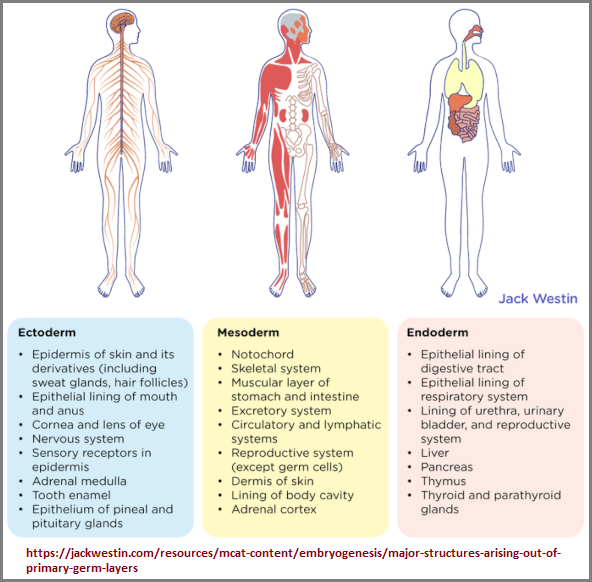
Another way of expressing the Germ layers is reference when we speak of animal life forms as being Diploblastic (having two germ layers) and Triploblastic (having three germ layers), with the latter group comprising what are called organisms with greater complexity and those a Diploblastic configuration as being less complex. Here again we see the use of prefixes which describe the quantities of "2" and "3", but do not necessarily speak of such in terms of a developmental scenario involving situations outside of a biology discussion.

In some cases we may encounter a pattern-of-three such as the Proton- Neutron- Electron, and find it difficult to differentiate a first, second, third developmental scenario. And I am not talking about in which sequence the particles were discovered by humans. In which order did they arrive in Nature? All at once? Two of them at once? One after the other? Or did they arrive later on the scene following the development of their constituent parts called quarks and the supposed gluons? (1st matter in the universe may have been a perfect liquid by Mara Johnson-Groh, June 02, 2021). When we look at the developmental scenario of the Earth participating solar system, we might well engage in the usage of a number line with respect to enumerating which planet came first, second, third and so on. If we focus primarily on the development of the Earth, we might again resort to the usage of a numbered time line, but not think to examine each representative staging as having its own underlying developmental scenario. A general scenario might illustrate a sequence of Earth, then the moon, then the oceans, then the atmosphere... up to the point where life begins, and call it some version of the History of Earth.
(4.6 billion years ago) When Earth formed 4.6 billion years ago from a hot mix of gases and solids, it had almost no atmosphere. The surface was molten. As Earth cooled, an atmosphere formed mainly from gases spewed from volcanoes. It included hydrogen sulfide, methane, and ten to 200 times as much carbon dioxide as today's atmosphere. After about half a billion years, Earths surface cooled and solidified enough for water to collect on it.
- Earth's atmosphere is 78% nitrogen, 21% oxygen, 0.9%
argon, and 0.03% carbon dioxide with very small percentages of other elements. Our atmosphere also contains water vapor. In addition, Earth's atmosphere
contains traces of dust particles, pollen, plant grains and other solid particles.
- Isotopes of Nitrogen: 2 stable Isotopes... Natural nitrogen (7N) consists of two stable isotopes: the vast majority (99.6%) of naturally occurring nitrogen is nitrogen-14, with the remainder being nitrogen-15. Fourteen radioisotopes are also known, with atomic masses ranging from 10 to 25, along with one nuclear isomer, 11mN. All of these radioisotopes are short-lived, the longest-lived being nitrogen-13 with a half-life of 9.965(4) min. All of the others have half-lives below 7.15 seconds, with most of these being below 620 milliseconds. Most of the isotopes with atomic mass numbers below 14 decay to isotopes of carbon, while most of the isotopes with masses above 15 decay to isotopes of oxygen. The shortest-lived known isotope is nitrogen-10, with a half-life of 143(36) yoctoseconds.
- Isotopes of Oxygen: There are 3 known stable isotopes of oxygen (8O): 160, 170, 180.
- Isotopes of Argon: 3 stable isotopes... Argon (18Ar) has 26 known isotopes, from 29Ar to 54Ar and 1 isomer (32mAr), of which three are stable (36Ar, 38Ar, and 40Ar). On the Earth, 40Ar makes up 99.6% of natural argon. The longest-lived radioactive isotopes are 39Ar with a half-life of 269 years, 42Ar with a half-life of 32.9 years, and 37Ar with a half-life of 35.04 days. All other isotopes have half-lives of less than two hours, and most less than one minute. The least stable is 29Ar with a half-life of approximately 4×10-20 seconds.
- Isotopes of Carbon: 2 stable isotopes... Carbon (6C) has 15 known
isotopes, from 8C to 22C , of which 12C and 13C are stable. The longest-lived radioisotope is 14C,
with a half-life of 5.70(3)×103 years. This is also the only carbon radioisotope found in nature—trace quantities are formed cosmogenically by the reaction
14N + n → 14C + 1H. The most stable artificial radioisotope is 11C, which has a half-life of 20.3402(53) min.
All other radioisotopes have half-lives under 20 seconds, most less than 200 milliseconds. The least stable isotope is 8C, with a half-life of
3.5(1.4)×10-21 s.
- Other Isotopes in the Atmosphere: Carbon Dioxide
- Water Vapor
Of interest to be garnered from the foregoing exercise is to point out that there are many more unstable isotopes as stable ones and that the stable ones don't appear to exceed the value of three. If this carries over into human society, then we might well entertain the notion that there are more unstable "elements" of society (such as people) than there are stable ones... but how do we measure such a consideration... and how do we effectively measure stability if it is primarily limited to a recurring exercise of three that may not be easily determined because of all the embellishments, deflections, obfuscations, concealments, secrecies and all the other forms of camouflaging being employed by institutions, governments, religions, businesses and individuals? Some civilizations, as noted by history such as the Roman Empire may come across as being stable for many years, but do in fact have a "half life" which marks their eventual demise, restructuring, remaking, revolution, re-constitution, etc... Is there a common theme to be derived and thus noted as a tool by which we can measure the shelf life of a civilization? Is it human sacrifice...one's own or others or both? For example, war can be viewed as a type of internal and external form of sacrifice.
Some readers may have imaginatively thought of looking at individuals, cars, sports, etc., as representing interactive atomic particles, and others include the view that societies are like interactive atomic particles. While the analogy is prosperous for an entertainment value, a one-for-one particle association may not be a typicality for most imaginative explorers. Other readers of course may view society in terms of chess, checkers, billiards, economic theory, chemistry, sports, as an insect colony, set theory in mathematics, a puzzle, a roulette wheel or Ponzi scheme, etc... However, when I exam different perspectives such as these, there are underlying patterns to discern and those patterns often reveal a limitation. While one might want to think that the short life span of humans necessarily causes perceptions to regulate observations into categories which have life spans themselves... otherwise called limitations, we must then think that humanity is unwittingly imposing or projecting its currency of life onto all things. Whereas we can describe an assumed "forever" or "for always" or "immortality" or eternity or infinity, but we don't actually know what these ideas mean. Some readers may think they do, but since we can even distinguish a time limit to the Universe, it appears that the Nature of Nature is one in which it can not adequately illustrate such notions either. How can there be a forever if there has never been one, in terms of a beginning and ending to the Universe in which one's supposed immortality and eternity are supposed to reside, unless we enable ourselves to conceptualize outside the present box of our existence in which we define multiple three-patterned orientations of reality?
If we don't allow the present two-patterned Mathematics to constrain imagination, can not there be more-than-three geometries to the Universe? Yet, why do we allow a two-patterned mathematics to collar us just like the two-patterned Yin/Yang model constrained the views of those in the past, and others in the present? And yet, even when we do think of more than three shapes, we are inclined to conclude there are only 3-manifolds: The Shape of the Universe: Ten Possibilities (Recent experimental evidence has hinted that the shape of the universe may be found among the ten orientable Euclidean 3-manifolds) by Colin Adams and Joey Shapiro.
Why do we create tools such as mathematics to restrict... though others say guide... our efforts of seeing reality and making use of perceive materials? Couldn't humans live in a reality in which there were 10,000 elements in a periodic table? Couldn't we live with 20 eyes, 50 fingers, and wings? Whereas we could adapt, this is not what we are confronted with. And though we can count higher than a primitive's three-patterned 1-2-many, so much of reality uses a pattern-of-three, or two, or one, or a 3-to-1 ratio... and sometimes multiples thereof. Is it a world of ones, twos and threes which guides our development of perceptions, or an inherent three-patterned blue-print projecting itself outward?
While I have it in mind, let me state that I think Mathematics is a Western- developed philosophy of underlying dualities (just like the Eastern- developed Yin and Yang philosophy) where Mathematics strives to develop a trichotomized functionality (such as the three-part Boolean logic or the three-part Pythagorean theorem (or Pythagorean Triple)... much like the proposed trichomously oriented idea of Triads found in the I-Ching; (though the triads are merely embellished biads since none of the groupings have an actual three-lines illustration. Only one and two line configurations are repeated due to its primitive association with human sexuality).
What both Mathematics and the Yin+Yang/I-Ching express are cognitive limitations of ideas that... when enumerated... show the repetition of an underlying early three-patterned (1- 2- Many) counting formula being expressed by human cognitive activity in particular (culture-specific) models of elaboration. Both are crude tools which, when in the hands of a skilled practitioner, can result in useful works of art... some of which are commercially viable. Indeed, both Mathematics and the Yin+Yang/I-Ching take on artistic expressions when subjected to the inclined cognitive activity of partitioners with a penchant for artistic expression set in the medium most familiarly used in a given subject in a given context. All mediums have their respective limitations and applications. Be it numbers, words, colors, sounds, electrical force, wood, stone, clay, paint, textile, etc... However, this is not to say that such ideas can not be used to create useful items for everyday use and influence imaginative excursions from which may emerge what are thought to be original creations. Nonetheless it is helpful for us to recognize the limitations of our cognitive behavior and establish the perspective that the patterns we uncover may change over time, and these changes may be related to environmental conditions humans are forced to adapt to.
A person looking for standard patterns of thought, of behavior, of emotion, or some particularity of social or language commonality within and/or across human cultures, may think they are being broad- or open- minded if they look for the same or similar activity in other life forms... and in fact have looked outside of humans at non-biological activity in nature but engaged in some anthropomorphic interpretation such as by claiming the behavior of oceans is under the control of a human- looking god named Poseidon, that lightning is the signature tool of a human- looking Zeus, that love is over-seered by the human- looking god Eros, etc... While in ancient times people did not have electric fences, a gang of riders with guns in holsters or rifles/shotguns or thought to put up highly visible and multiple "no trespassing" signs, they created ideas such as a three-headed creature (sometimes called a monster) in the form of a dog named Cerberus whose responsibility was to guard the gates of the underworld. No less, there were other creatures whose behavior suggested a god or demon directed responsibility to guard or watch-over a bridge (such as in the case of some trolls), or a human-like spectre to Ferry the dead across a river such as Charon. (Multiple other creatures in myth, legend, fairy tales, science fiction, etc., exist as examples of limitation.)
Note: in searching for information on trolls I came across this site: (Trolls and Maidens and the magic of bridges), where I found: "There are three basic types of historic bridges on Dartmoor: stone bridges, wooden bridges (called clams) and clapper bridges (made of large granite slabs). The word "clapper" is believed to have derived from an old Anglo Saxon word cleac, mean a stepping stone." H.O.B note: The word "clapper" is probably derived from the sound some stones make as you walk over them because they are not evenly set on the ground. They "clap" as you step on them. This idea should have accompanied the explanation of the word.
We tend to overlook the fact that humans are a type of medium on which, through which, because of which biology expresses its limitations. And while saying there are Billions of life forms may overwhelm you sense of valuation, to me it details the extent of limitation we are being confronted with. For example, the Periodic table of the elements expresses a limitation. One can rightly ask why the so-called Big Universe doesn't have millions of different elements. Instead, it is only a handful. Likewise, why isn't every human a genius? Why only a handful. And if you are going to be generous in your interpretation of humanity and say that all humans are geniuses in their own right, in their own way;, we are still left with the fact that the quantity of humans expresses a limitation and that limitation is subjected to the limiting factor called death. Indeed, why is the human life cycle sometimes described sometimes in a three-patterned way of "birth- life- death" (or birth- young- adult), and insects limited to less than 10 stages? Is there a number bias on some occasions?:
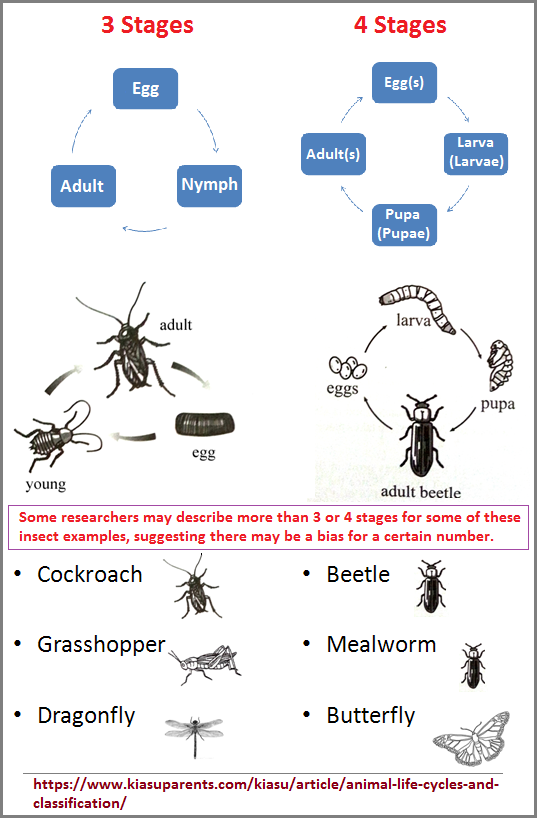
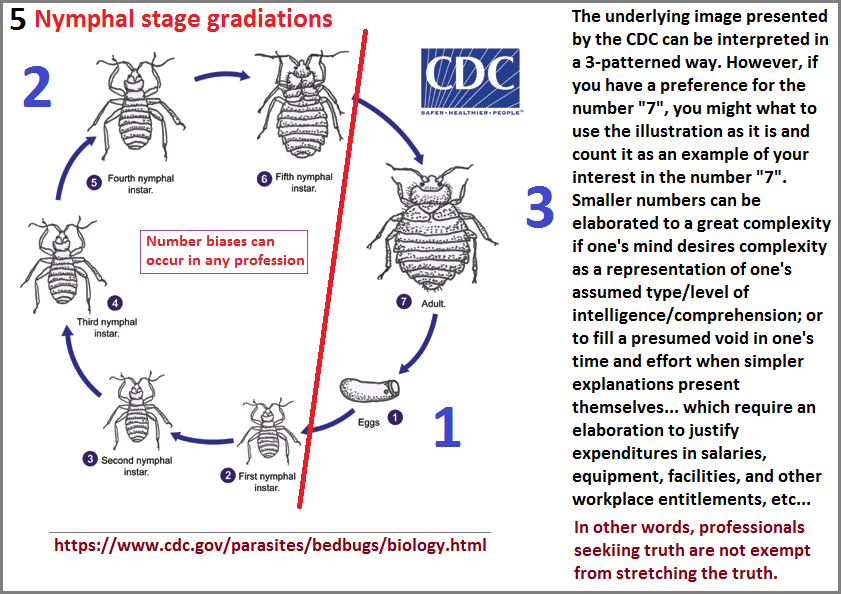
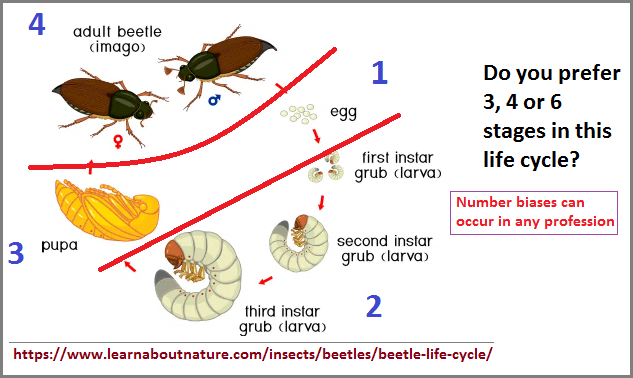
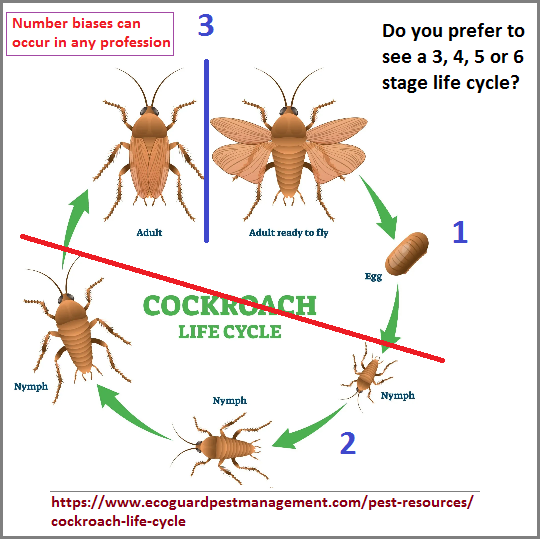
(Second half of this page moved to page 28)
Date of (series) Origination: Saturday, 14th March 2020... 6:11 AM
Date of Initial Posting (this page): 1st March 2022... 6:04 AM
Updated Posting:Wednesday, 26th October 2022... 7:34 AM, MST; Albuquerque, NM.